Introduction to Stages of Counselling Process
The counselling process is inherently dynamic, characterized by a series of stages that collectively contribute to its effectiveness. These stages generally include rapport building, problem identification, goal setting, intervention, and follow-up. The quality of the counsellor-counselee relationship significantly impacts the success of each stage, making the development of a strong therapeutic alliance a cornerstone of effective counselling.
The stages of the counselling process are not linear but rather cyclical, with each stage influencing and interlinking with the others. The strength of the counsellor-client relationship, established during the initial stages, profoundly affects the entire therapeutic journey. Understanding these stages and their implications helps counsellors provide better support and achieve more successful outcomes.
Stages of the Counselling Process

Stages in the Counselling Process
STAGE 1: Developing a Counseling Relationship
The initial stage of counselling is crucial for setting the tone of the therapeutic relationship. This stage focuses on building rapport and establishing trust, which are essential for creating a safe environment where clients feel comfortable sharing their concern. Some of the important processes in the first stage include-
- Building Rapport and Trust– Establishing rapport involves creating a connection with the client that fosters trust. This is achieved through demonstrating empathy, respect, and genuineness. For example, a counsellor might use reflective listening to show understanding, such as, “It sounds like you’ve been feeling overwhelmed by recent changes at work.” This approach validates the client’s feelings and builds a foundation of trust.
- Predictability and Consistency- During the first stage, it is crucial for the counsellor to be both predictable and consistent. Clients need to know that they can rely on the counsellor to be stable and supportive. This predictability helps in reducing any initial anxiety and fosters a sense of safety.
- Testing and Confidentiality- Clients, especially younger ones, may use testing behaviours to assess the counsellor’s reliability and care. Establishing confidentiality early in the relationship reassures clients that their disclosures will be kept private, thereby fostering trust.
Carl Rogers, a pioneering figure in humanistic psychology, identified three core conditions that are essential for fostering a successful therapeutic alliance: empathic understanding, unconditional positive regard, and congruence. These conditions serve as the foundation for a supportive and productive therapeutic relationship.
- Empathic Understanding-
Empathy involves deeply understanding and sharing the feelings and perspectives of the client as if they were your own. This means not only acknowledging the client’s emotional state but also perceiving the world from their viewpoint.
Empathy is crucial for building rapport between the counsellor and the client. When clients feel that their emotions and experiences are genuinely understood, they are more likely to open up and engage in the therapeutic process.
Furthermore, an empathetic approach fosters trust and safety, allowing clients to express their vulnerabilities without fear of judgment. Counsellors demonstrate empathy through active listening techniques, such as reflecting back what the client has said and validating their feelings.
For instance, if a client expresses frustration about their job, a counsellor might respond with, “It sounds like you’re feeling really overwhelmed by your current work situation. Can you tell me more about what’s been bothering you?” Additionally, by mirroring the client’s emotions, counsellors show that they are attuned to the client’s emotional state.
2.Unconditional Positive Regard-
Unconditional positive regard refers to the counsellor’s acceptance and support of the client regardless of their actions, thoughts, or feelings. This condition emphasizes valuing the client as a person of worth, separate from their behaviours or circumstances.
By offering unconditional positive regard, counsellors create a safe and accepting environment where clients can explore their thoughts and feelings without fear of criticism or rejection. This acceptance is particularly important for clients struggling with low self-esteem or self-worth.
Counsellors maintain an open and accepting attitude, avoiding any form of judgment about the client’s experiences or choices.
For example, if a client admits to making a mistake, the counsellor’s response should be supportive rather than critical, such as, “I understand that this was a challenging situation for you. Let’s explore what you can learn from it.” Additionally, counsellors respect the client’s autonomy and decisions, even if they do not align with the counsellor’s own beliefs or values, helping clients feel valued and supported in their personal growth journey.
3.Congruence-
Congruence, or authenticity, involves the counsellor being genuine and transparent in their interactions with the client. This means that counsellors’ words, actions, and feelings are in harmony, providing a consistent and honest presence in the therapeutic relationship.
Congruence helps in building a genuine and trustworthy relationship between the counsellor and the client. When counsellors are authentic, clients are more likely to feel comfortable and engage openly in the therapeutic process.
Moreover, by demonstrating congruence, counsellors model authenticity for their clients, encouraging them to be more honest and open about their own feelings and experiences. Counsellors express their true feelings and thoughts appropriately within the context of the therapeutic relationship.
For instance, if a counsellor is feeling concerned about a client’s progress, they might share this concern honestly, while framing it in a supportive and constructive manner, such as, “I’m feeling a bit concerned about how things are going. How do you feel about our progress so far?” Ensuring that verbal and non-verbal communications are consistent is crucial, as any incongruence can undermine the therapeutic relationship.
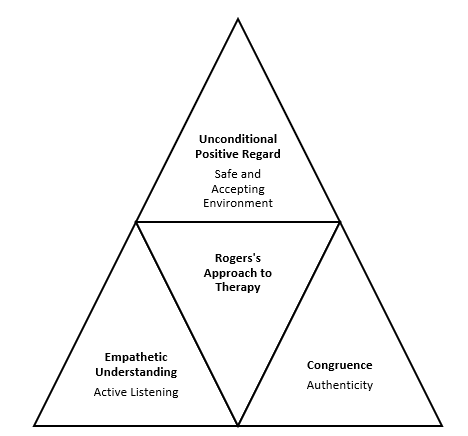
Rogerian Psychotherapy
In addition to Rogers’ core conditions, Carkhuff (1969) introduced additional elements that further enhance the therapeutic alliance. These elements include:
- Respect– Respect strengthens the focus and importance of the counselling process. It involves recognizing and valuing the client’s individuality and experiences, which helps in creating a collaborative and respectful relationship.
- Confrontation: Confrontation involves offering realistic and accurate feedback to clients. It helps clients gain a clearer understanding of their issues and encourages them to address inconsistencies or discrepancies in their thoughts or behaviours.
- Immediacy: Immediacy refers to considering problems with a present-focused attitude. It involves addressing issues as they arise in the therapeutic relationship, which helps in resolving them promptly and effectively.
- Concreteness: Concreteness involves paying attention to practical aspects of the counselling process. It ensures that interventions and strategies are specific and actionable, which aids in achieving the client’s goals.
- Self-Disclosure: Self-disclosure involves sharing relevant personal insights or experiences with the client. This can help clients feel more connected and understand the counsellor’s perspective, fostering a deeper therapeutic relationship. Read more
In conclusion, some of the most important processes in the first stage includes developing rapport. The “getting to know you” phase is critical for setting the stage for effective counselling. During this phase, counsellors should focus on several key tasks:
- Establishing Structure and Form: Setting clear expectations and boundaries for the counselling process helps both parties understand their roles and responsibilities. This includes defining the scope of the counselling relationship and agreeing on the logistics of sessions.
- Informed Consent: Ensuring that clients are aware of the counselling process, including confidentiality and the nature of interventions, is essential for building trust. Informed consent helps clients feel secure and confident in the therapeutic relationship.
- Setting Initial Goals: Collaboratively setting achievable goals for the counselling relationship provides direction and purpose to the therapeutic process. This helps in creating a sense of partnership and commitment between the counsellor and the client.
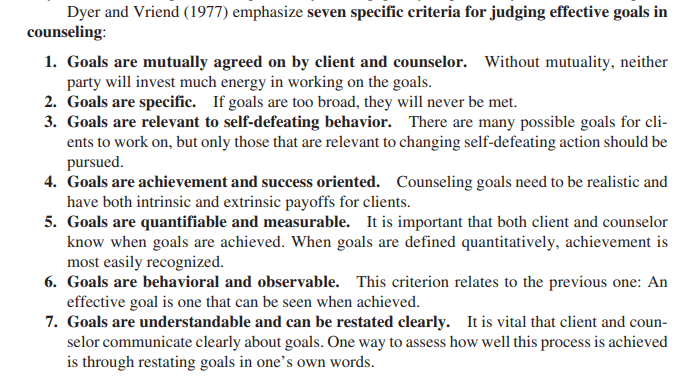
Dyer & Vern’s Criteria for Setting Goals (Gladling, 2012)
Integrating the Core Conditions
While each of these core conditions—empathic understanding, unconditional positive regard, and congruence—are crucial individually, their integration is what creates a truly effective therapeutic environment. Together with Carkhuff’s additional elements, they help establish a strong therapeutic alliance where clients feel understood, accepted, and supported.
Counsellors should strive to embody these conditions consistently throughout the therapeutic process, integrating them into every interaction with the client. By doing so, they can enhance the effectiveness of their interventions and support clients in achieving their therapeutic goals.
STAGE 2: Working in the Counseling Relationship
Once rapport and trust are established between a counsellor and client, the focus shifts to actively working within the relationship to address the client’s issues. This stage involves several critical activities: exploring problems, setting goals, and developing and implementing strategies for change. Effective counselling relies on various models that provide frameworks for working within the therapeutic relationship.
Notable among these are Nelson’s nine-step model, Egan’s three-stage model, and Fuster’s five-stage model. Each of these models emphasizes different aspects of the therapeutic process and contributes to creating a structured approach for managing the therapeutic relationship.
Marjorie Nelson’s Nine Steps (2001)
Nelson’s model provides a comprehensive approach to working within the therapeutic relationship, focusing on the detailed steps necessary to guide clients through the counselling process:
- Establish a Safe Environment: The initial step involves creating a counselling space where clients feel comfortable and secure. This environment should promote open and honest communication, allowing clients to express their concerns without fear of judgment.
- Clarify Concerns: Counsellors help clients articulate their issues clearly. This involves exploring the client’s perspective and ensuring that their concerns are understood in depth.
- Active Listening: Counsellors use active listening techniques such as paraphrasing, summarizing, and reflecting to fully grasp the client’s agenda. This helps in understanding the client’s issues from their point of view and validating their experiences.
- Reframe the Problem: The counsellor assists the client in reframing their problems into actionable goals. This step is crucial for moving from identifying issues to developing practical objectives for change.
- Explore Approaches: Counsellors work with clients to identify potential strategies for achieving the goals. This involves brainstorming and evaluating various methods to address the client’s concerns effectively.
- Develop a Plan: A detailed plan of action is created, outlining specific steps and strategies to achieve the client’s goals. This plan serves as a roadmap for the counselling process.
- Make a Contract: Counsellors and clients agree on the plan and outline the steps to be taken. This contract formalizes the commitment to the process and ensures mutual understanding of the objectives.
- Summarize and Evaluate: Progress is reviewed periodically to assess the effectiveness of the interventions. Counsellors clarify any aspects of the process and make necessary adjustments based on the client’s feedback and progress.
- Obtain Feedback: Gathering feedback from the client is essential for adjusting the approach as needed. This ensures that the counselling process remains responsive to the client’s needs and experiences.
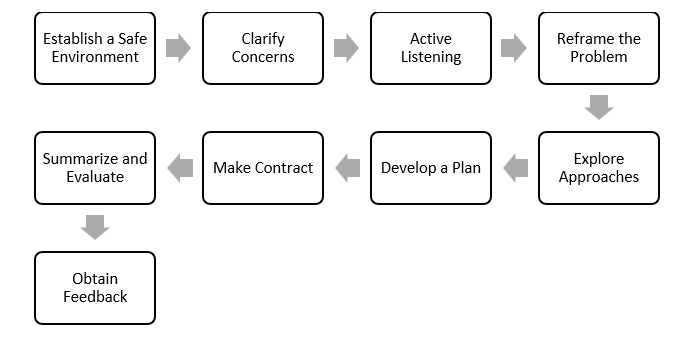
Nelson’s 9 Steps
Egan’s Three-Stage Model (1986)
Egan’s model offers a streamlined approach to managing the therapeutic relationship with a focus on three key stages:
- Exploration: In this stage, the client clarifies their understanding of the problems they face. They explore and articulate their experiences, with the counsellor helping to identify and clarify issues while uncovering blind spots and generating new perspectives. Egan gave the SOLER rule for non-verbal behaviour.
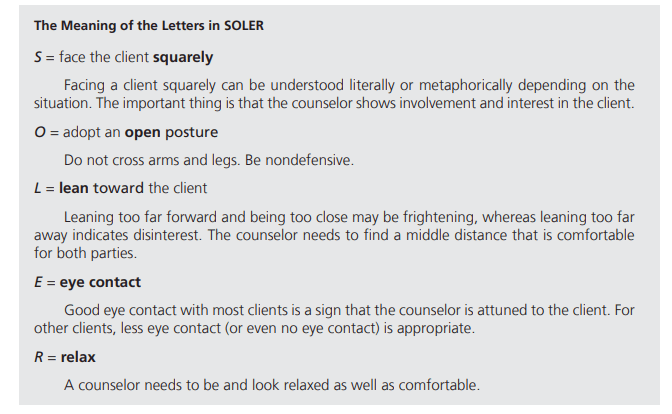
Egan’s SOLER model
2. Planning: The client develops strategies to improve their situation and sets specific goals for change. This involves envisioning a new scenario and creating a detailed plan for achieving the desired outcomes. The counsellor plays a supportive role in encouraging commitment to these goals.
3. Action: The client takes concrete steps to implement the strategies and work towards their goals. The counsellor assists in developing action plans and provides support to help the client stay focused and motivated.
Fuster’s Five Stages (2005)
Fuster’s model breaks down the therapeutic process into five stages, each emphasizing different aspects of working in the relationship:
- Attending: The counsellor focuses on the client’s needs and concerns, demonstrating active engagement and attentiveness.
- Responding: Feedback and support are provided to the client, helping them feel heard and understood. This stage involves responding to the client’s needs with empathy and validation.
- Personalizing: Interventions are tailored to the client’s specific situation, ensuring that strategies are relevant and effective for their unique context.
- Initiating: The planned strategies are implemented, marking the beginning of active work towards achieving the client’s goals.
- Evaluating: The effectiveness of the interventions is assessed, and necessary adjustments are made based on the client’s progress and feedback.

Fuster’s 5 Stage Model
In addition to these models, several techniques and strategies are vital for working effectively within the therapeutic relationship-
Changing Perceptions– Clients often enter counselling with distorted or unrealistic views of their situations. Counsellors help clients reframe these perceptions by providing a safe, accepting environment for exploration and challenging assumptions. For example, if a client believes that they are a failure because of a recent job loss, the counsellor might help them explore alternative perspectives, such as viewing the job loss as an opportunity for growth or a chance to pursue new interests.
Accurate Empathy– Effective counselling requires deep empathic understanding. Counsellors use accurate empathy to connect with the client’s experiences and provide validation. This involves not only understanding the client’s feelings but also communicating that understanding in a way that resonates with the client. For instance, if a client is struggling with grief, the counsellor might say, “It sounds like you’re feeling overwhelmed by the loss. It must be incredibly difficult to cope with these feelings.”
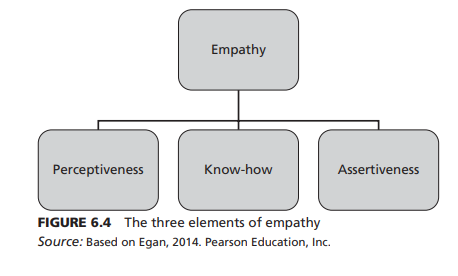
Accurate Empathy
- Self-Disclosure– Sharing relevant personal experiences or insights can enhance rapport and build trust. However, self-disclosure should be used carefully to avoid overshadowing the client’s concerns. For example, a counsellor might share a personal anecdote about overcoming a similar challenge, which can help the client feel less alone and more understood.
- Responding Styles– Tailoring responses to the client’s emotional, behavioural, or cognitive focus helps address their specific needs:
- Affective Responding: Focuses on the client’s feelings and emotional experiences. For example, if a client expresses sadness, the counsellor might respond with, “I can see that this situation is deeply affecting you.”
- Behavioural Responding: Addresses the client’s actions and behaviours. For instance, if a client is struggling with procrastination, the counsellor might discuss specific strategies for improving time management.
- Cognitive Response: Explores the client’s thoughts and cognition. For example, if a client is having negative thoughts about themselves, the counsellor might work with them to challenge and reframe these thoughts.
- Humour: Appropriate use of humour can lighten the atmosphere and build rapport. For example, sharing a light-hearted comment or anecdote can help ease tension and create a more relaxed environment.
- Confrontation: Gently challenging clients to confront difficult truths or inconsistencies can promote insight and growth. For instance, if a client’s actions contradict their stated values, the counsellor might ask, “How do you reconcile your actions with what you believe?
- Transference and Counter-Transference: Understanding and managing the projection of feelings between client and counsellor is essential. Counsellors should be aware of how their own feelings and past experiences might influence their responses to the client and vice versa. For example, if a counsellor feels unusually frustrated with a client, they should explore whether this response is related to their own past experiences or the client’s behaviour.
STAGE 3: Terminating the Relationship
The termination phase represents the culmination of the counselling process and is pivotal in ensuring that clients are equipped to manage their challenges independently. This stage involves preparing clients for the conclusion of therapy and facilitating the integration of changes made during the counselling process into their everyday lives. Effective termination requires careful planning and consideration of several key factors to ensure a smooth transition for both the client and the counsellor. Some of the key considerations during termination are-
1.Timing-
Determining the appropriate time to end counselling is a critical aspect of the termination phase. Effective termination should be based on the client’s readiness and the extent to which therapeutic goals have been met. Counsellors need to assess whether clients have achieved their goals, demonstrated significant progress, and developed the skills needed to address future challenges independently.
2.Resistance to Termination-
Resistance to termination can arise from both clients and counsellors. This resistance may stem from emotional attachment, fear of the unknown, or concerns about the future. Discussing the client’s progress and preparing them for the end of therapy can help alleviate fears and build confidence in their ability to handle future challenges.
3. Premature Termination-
Premature termination occurs when clients choose to end counselling before achieving their goals. This can be due to various reasons, such as financial constraints, external pressures, or changes in personal circumstances. Counsellors should approach premature terminations with sensitivity and understanding. Providing a summary session to review the client’s progress, discuss accomplishments, and address any remaining concerns can be beneficial.
4. Referrals–
When termination is deemed appropriate, counsellors may need to refer clients to other professionals for continued support. Referrals are especially important if clients require specialized services or additional support beyond what can be provided in the current counselling relationship. Counsellors should ensure that clients are informed about the referral process and comfortable with the recommended professionals. Providing clients with relevant information and offering assistance in making the referral can help ease the transition and ensure that clients continue to receive the support they need.
5. Follow-Up-
Scheduling follow-up sessions can be a valuable part of the termination phase. Follow-ups offer an opportunity to evaluate the client’s long-term progress, address any ongoing issues, and provide additional support if needed. These sessions can also provide valuable feedback for future improvements in the counselling process.
Conclusion to Stages of Counselling Process
Understanding the counselling process requires a comprehensive approach that includes all stages from engagement to termination. The effectiveness of counselling hinges on building a strong therapeutic relationship, which is established through developing rapport, trust, and a collaborative working relationship. Each stage of the counselling process—whether it’s forming the initial connection, actively working through issues, or preparing for termination—plays a critical role in supporting clients toward achieving their therapeutic goals.
The stages are interrelated and cyclical, reflecting the dynamic nature of therapy. Developing a solid foundation in the early stages is crucial for setting the stage for effective problem-solving and goal achievement. Active engagement within the relationship, guided by models such as Nelson’s nine-step model, Egan’s three-stage model, and Fuster’s five-stage model, ensures that counsellors and clients collaboratively work toward meaningful change. Finally, the termination phase, while challenging, is essential for consolidating gains, managing resistance, and preparing clients to navigate their challenges independently.
By integrating Carl Rogers’ core conditions of empathic understanding, unconditional positive regard, and congruence, along with additional elements like respect and self-disclosure, counsellors can enhance the therapeutic alliance and facilitate positive outcomes. Managing the complexities of termination with sensitivity, including handling premature terminations, providing referrals, and conducting follow-ups, helps ensure that clients are well-equipped for their ongoing journey.
References to Stages of Counselling Process
Carkhuff, R. R. (1969). The art of helping. Holt, Rinehart & Winston.
Egan, G. (1986). The skilled helper: A systematic approach to effective helping (2nd ed.). Brooks/Cole Publishing Company.
Fuster, J. M. (2005). The cognitive neuroscience of human cognition. Springer.
Gladling, K. R. (2012). Counselling process and techniques. Sage Publications.
Nelson, M. L. (2001). Nelson’s nine-step model of counselling. Counselling and Development.
Rogers, C. R. (1957). On becoming a person: A therapist’s view of psychotherapy. Houghton Mifflin.
Subscribe to Careershodh
Get the latest updates and insights.
Join 18,523 other subscribers!
Niwlikar, B. A. (2023, December 11). Stages of Counselling Process- Master the 3 Models of Counselling. Careershodh. https://www.careershodh.com/3-stages-of-counselling-process/
